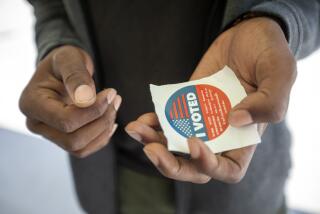‘Instant Runoff Vote’ Debuts in S.F.
- Share via
SAN FRANCISCO — With national attention focused on electronic voting machines, San Franciscans are bracing for a different break with voting tradition.
This city puts itself under the microscope Tuesday by becoming the first major municipality in the country to allow voters to rank multiple candidates in local elections.
Election officials and proponents of the system usually called “instant runoff voting” say they expect no glitches. They note that early balloting here indicates that voters are catching on.
“It’s going very smoothly,” elections director John Arntz said.
But critics predict voter confusion, delays at the polls and a potpourri of other crises -- most notably for immigrant, first-time voters.
“They’ve never test-run this system ... so everybody is going to be learning,” said David Lee, director of the Chinese American Voter Education Committee. “If it’s a spectacular success in San Francisco, you can bet other cities are waiting in the wings [to adopt it]. But if it fails here ... nobody’s going to want to touch this thing.”
Under the system -- in use to fill seven open Board of Supervisors seats -- voters rank their top three candidates in order of preference. If no one wins at least 50% of the votes when first choices are tallied, the candidate with the fewest votes is eliminated. The second choice of those voters is then added to the remaining candidates’ tallies. The process continues until a majority winner emerges.
Proponents say the method gets rid of costly runoff elections, gives voters more say and encourages participation from minor candidates: Even if a first-choice candidate is eliminated, voters can still be heard if their second and third choices come into play.
In use in Ireland, Australia and London, the method known here as “ranked choice voting” would eliminate the “spoiler” effect. If it had been in place during the 2000 presidential race, backers note, Ralph Nader’s voters probably would have thrown their second-choice votes to Democrat Al Gore.
San Francisco won state approval last summer for the system, which requires its own ballots and software. Names of all candidates in a race appear in three repeating columns. Voters mark their first choice in column one, second in column two and third in column three.
Education efforts have sought to discourage voters from marking only a first choice, or selecting the same candidate in all three columns, because those voters would be silenced if that candidate were eliminated.
Arntz said about 55,000 of 145,000 absentee ballots have been returned, and most appear to have been marked correctly. Early voting at City Hall also was going well, he said.
Opponents worry that it could take weeks to get results for races with the largest number of candidates. (One race has 22). Only the first round of votes will be available election night. The computer system will run the consecutive rounds of elimination and re-tally the votes Wednesday. The process then will be repeated as absentee and provisional ballots trickle in.
Voting machines that receive incomplete or improperly marked ballots at the polls will flash and beep. Alerted poll workers then will ask people if they intended to vote as they did. Critics say that could violate privacy.
Steven Hill of the Center for Voting and Democracy, the chief proponent of the system, called those concerns overblown.
“In 2000, people were screaming because voters [in Florida] made mistakes. Now we have a system where voters aren’t going to make mistakes and they’re screaming about that,” he said. “We’re erring on the side of helping the people who are less informed.”
Lee, meanwhile, worries that immigrants have not been properly educated. The largest number of Asian Americans in city history is expected to participate in this election -- many for the first time, Lee said.
Delays and efforts by poll workers to ensure that ballots are marked correctly could intimidate immigrants at the polls, he said, while those who vote at home could simply botch their ballots.
An example of the potential problems: Many new voters have walked into his office in recent days seeking help. Lee said some had followed directions to select three candidates, but marked them all in the first column, spoiling their ballots.
More to Read
Sign up for Essential California
The most important California stories and recommendations in your inbox every morning.
You may occasionally receive promotional content from the Los Angeles Times.











